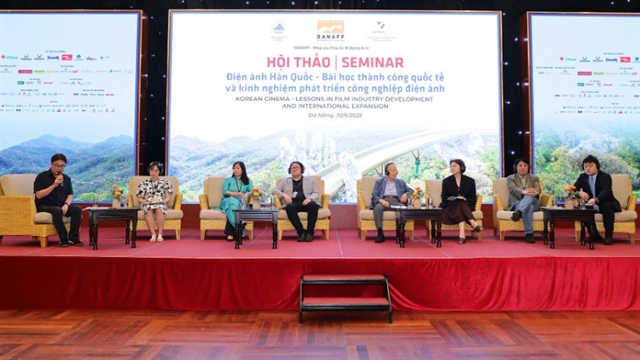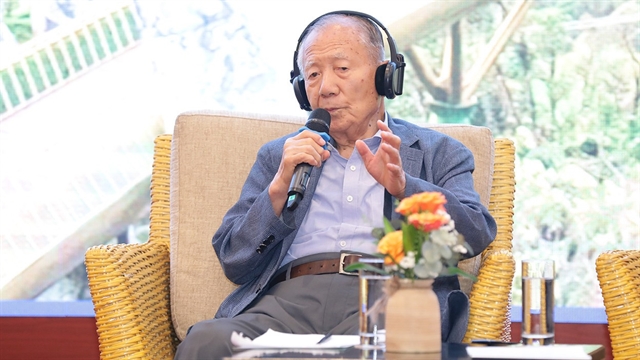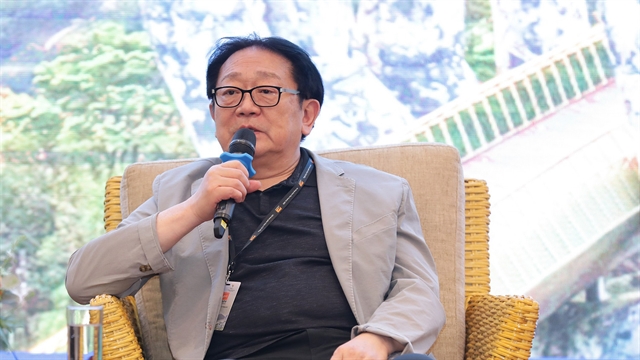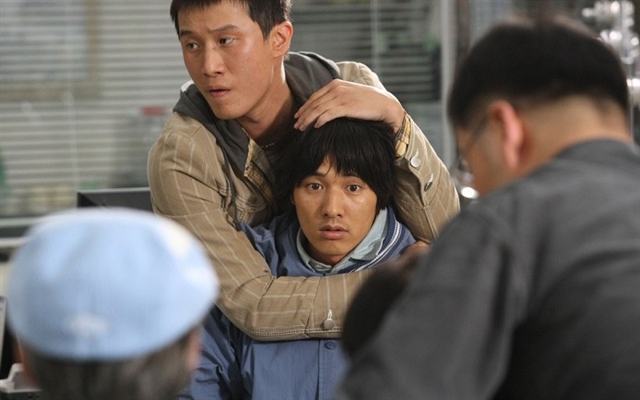 Life & Style
Life & Style


|
| The seminar titled 'Korean Cinema – Lessons in Film Industry Development and International Expansion'. Photo courtesy of DANAFF |
By Trần Khánh An
ĐÀ NẴNG — Valuable insights into film industry development were shared by veteran Korean filmmakers, researchers and cinema policymakers during the seminar in Đà Nẵng last week.
Titled 'Korean Cinema – Lessons in Film Industry Development and International Expansion', the event was part of the third Đà Nẵng Asian Film Festival (DANAFF III).
It offered a comprehensive look at how South Korea transformed its cinema into a global cultural powerhouse and how Việt Nam's movie sector can learn valuable lessons.
Ngô Phương Lan, the Director of DANAFF III, said: "As Việt Nam works to develop its film industry, which is considered a key pillar of the country’s cultural sector, we recognise that our experience is still limited. We need to learn from more established cinematic industries. In this regard, South Korea stands out as a shining example."
Lan said that Korean and Vietnamese films produced in the 1960s shared many similarities. However, just a few decades later, Korean cinema experienced explosive growth, especially with the global rise of the Hallyu wave, which amplified its appeal worldwide.
She noted that few film industries have managed to strike such a rare balance between commercial success and the achievement of arthouse films.
Yang Yun-ho, Vice President of the Korean Film Council (KOFIC) believes that works like Parasite, which explores humanity within a class-divided society, Minari, a heartfelt story about immigrant roots and family and Squid Game, with its bold social imagination, all tell deeply Korean stories that nonetheless resonate with universal human emotions.
He added: "Behind these successes lie the sweat and passion of creative minds, a fearless spirit of experimentation and a dynamic film ecosystem that embraces diverse voices."
A New Wave of Young Filmmakers

|
| Kim Dong-ho, former chairman of the Busan International Film Festival (BIFF). Photo courtesy of DANAFF |
The Korean film industry experienced significant growth during the 1950s and 1960s, but then fell into decline in the 1970s and 1980s as film production dropped sharply.
Park Kwang-su, filmmaker and current chairman of Busan International Film Festival (BIFF), said: "In the 1980s, there were hardly any active filmmakers in South Korea; even at Seoul National University, there were no film students making films."
The 1980s to the 2000s marked a turning point for Korean cinema, driven by both creative breakthroughs and progressive policy changes.
Kim Dong-ho, former chairman of BIFF, said that a key factor behind the success of Korean cinema was the emergence of a new wave of young directors, such as Park Kwang-su and Jang Sun-woo, who carried a strong ambition to create truly meaningful films.
Later, in 1996, a new generation of filmmakers, including Kim Ki-duk, Hong Sang-soo and Lee Chang-dong, further enriched Korean cinema with bold narratives and distinctive styles.
The revival was supported in part by policy changes. In 1986, the amendment of the Film Law opened up the industry and leading to a significant increase in production companies. By 1996, South Korea officially abolished film censorship, replacing it with an age-based classification system.
"Since 1996, when the BIFF was established, there has been a growing need to introduce emerging directors and new Korean films to the global market," he added.

|
| Park Kwang-su, filmmaker and current chairman of the Busan International Film Festival (BIFF). Photo courtesy of DANAFF |
Kwang-su also emphasised the growth of a skilled workforce within the film industry.
While South Korea began establishing more production companies in the 1980s, a major challenge was that emerging directors couldn’t depend on outdated systems or existing crews.
He said: “We had to reconstruct the entire foundation, from assembling new teams to redefining the cinematic language. Many of us were filmmakers who had trained overseas, and we had to restart the industry together.”
Government’s pivotal role
They also emphasised the pivotal role of the government in the development of Korean cinema through KOFIC, especially in supporting independent filmmakers. In 1999, the organisation underwent a major transformation when it was restructured to include nine members, primarily made up of young professionals and experts.
Park Hee-seong, Policy Researcher at the Policy Research Department of KOFIC, said: "Beyond being an agency that directly supports filmmaking, KOFIC positions filmmakers themselves as the central force of the industry. The organisation provides support but does not impose rigid regulations and interfere with the creative process.
"KOFIC offers comprehensive support for the film industry, particularly through the removal of the censorship mechanism and the recruitment of fresh, forward-thinking individuals to contribute to the development of Korean cinema."
KOFIC partners with public agencies to offer seed funding from government budgets, attracting further support from the private sector and civil society to expand investment in independent productions.
"Bong Joon-ho’s film Mother received financial support to submit to the Cannes Film Festival and the Oscars in 2009," Park said.

|
| A Scene in 'Mother' (2009) by Bong Joon-ho. Photo courtesy of CJ Entertainment |
KOFIC tracks box office performance to determine when initial investments can be recovered, allowing investors to quickly estimate potential returns and encouraging greater capital flow into the film industry. It also operates film academies to train and upskill professionals in the industry, helping strengthen the sector’s overall capacity.
South Korea also implements various policies to bring classic films to international audiences as part of global promotion efforts through the Korean Film Archive (KOFA).
Kim Hong-joon, Director of KOFA, explained that the archive’s core mission is to digitally restore these films so they can be screened at film festivals worldwide and distributed to schools, cultural institutions, and museums across the globe.
In addition, KOFA makes select copyrighted classics accessible to a wider audience through its official YouTube channel, Korean Classic Film.
“We realised that simply presenting a film is not enough; it must be translated into other languages to truly reach global audiences," Hong-joon added.
"We believe that if Vietnamese cinema starts with these fundamental steps, it can gradually find international success.” — VNS




